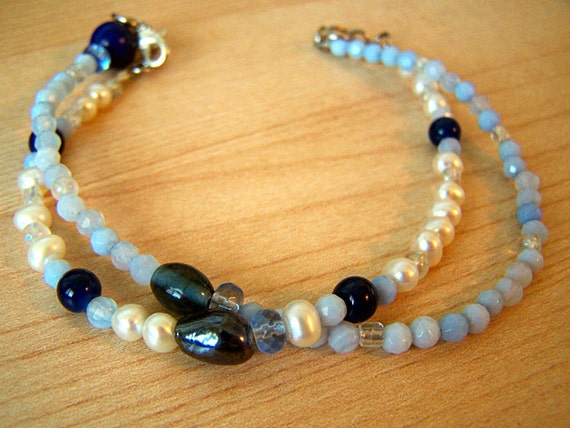Anyway!
Kris, who works at a small start-up, was tasked with shopping for a thank-you gift for their summer intern, a sustainable engineering student in Seattle (since she worked for them for free). Kris spotted one of my irrational memory wire cuff bracelets and sent me a message about the possibility of a custom order. I jumped at the chance because I love custom orders. I love the ideas other people have about math in jewelry and/or the challenge of working within a specific color palette. This piece had both.
As this intern had worked quite a bit with water pressure, Kris suggested the William–Hazens equation of pressure drop and shades of blue reminiscent of water. The equation actually worked out to a near-perfect bracelet length in both the numerator and the denominator—one of the constraints of using physical constants or ratios is that you don't have much wiggle room because you have very specific (and limited) numbers to work with, so I was relieved to see there wouldn't be much fudging with lengths. In addition to the blues, I added freshwater pearls as a neutral and also to reinforce the water theme.
Hopefully that made some sense!
As I said earlier, things worked out to near-perfect length, but only near perfect. I know personal preference on this varies, but I cannot stand loosey-goosey bracelets. Lawyer Mom and I have wrists that are about the same size but anything I make for her is a good two inches longer than what I make for myself, and this came out more towards the Lawyer Mom end of the spectrum. I added a few links on the end so that it can be worn as a snug-fitting anklet or loose-fitting bracelet, whatever the mood and preference.
Fortunately everything in this equation is multiplied (except the ratio itself). As you all recall from math class, when two numbers are written next to each other (ideally in parentheses), then you should multiply them. I didn't have to come up with something else to represent addition or subtraction, and I think two strands is a great way to represent a fraction/division. Maybe I should invest in some neutrally-colored "+" and "–" beads in case of just such an emergency?
All in all, this was a fun project. While I don't know if I'll be revisiting the William–Hazens equation specifically, I'm definitely going to be cruising more equations and ratios to see what I can come up with!
If you care to check this against the above link, the strand with freshwater pearls represents the numerator (the three blue beads are the spacers between each digit). The strand with blue lace agate represents the denominator (Czech glass as the spacers).
The real fun in this piece came with representing variables. I've never had to do that before—usually I work with pure numbers. But the whole thing seemed empty without any variables, so I went a little more abstract with this piece. Those heretofore unexplained large glass beads represent those variables, and the faceted blue glass you see next to them function like carats, indicating the variable is raised to a power (a power spelled out by the rest of the beads). So (large bead)(faceted rondelle)(smaller beads) means: X (large) ^ (raised to the power of; faceted rondelle) 1.85 (smaller beads).
Hopefully that made some sense!
As I said earlier, things worked out to near-perfect length, but only near perfect. I know personal preference on this varies, but I cannot stand loosey-goosey bracelets. Lawyer Mom and I have wrists that are about the same size but anything I make for her is a good two inches longer than what I make for myself, and this came out more towards the Lawyer Mom end of the spectrum. I added a few links on the end so that it can be worn as a snug-fitting anklet or loose-fitting bracelet, whatever the mood and preference.
Fortunately everything in this equation is multiplied (except the ratio itself). As you all recall from math class, when two numbers are written next to each other (ideally in parentheses), then you should multiply them. I didn't have to come up with something else to represent addition or subtraction, and I think two strands is a great way to represent a fraction/division. Maybe I should invest in some neutrally-colored "+" and "–" beads in case of just such an emergency?
All in all, this was a fun project. While I don't know if I'll be revisiting the William–Hazens equation specifically, I'm definitely going to be cruising more equations and ratios to see what I can come up with!


This comment has been removed by the author.
ReplyDeleteThis is really cool! Also, I just started using HabitRPG today! I was planning to write about it next week hahah.
ReplyDeleteP.S. - I saw this knitting pattern the other day and it reminded me of your Trek Thursday posts!
http://makezine.com/craft/diy-klingon-batleth-scarf/?utm_source=feedburner&utm_medium=feed&utm_campaign=Feed%3A+craftzine+%28CRAFT%29
This is really cool! Also, I just started using HabitRPG today! I was planning to write about it next week hahah.
ReplyDeleteP.S. - I saw this knitting pattern the other day and it reminded me of your Trek Thursday posts!
http://makezine.com/craft/diy-klingon-batleth-scarf/?utm_source=feedburner&utm_medium=feed&utm_campaign=Feed%3A+craftzine+%28CRAFT%29
AHHH THAT IS AMAZING I wish I could knit~~~~
ReplyDelete